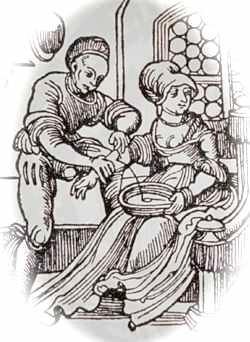Phlebotomy: A Historical Perspective [ Countinue Reading . . . . . . . . . ]

Some authorities believe phlebotomy dates back to the last period of the Stone Age, when crude tools were used to puncture vessels and allow excess blood to drain out of the body. A painting in a tomb showing the application of a leech to a patient evidences bloodletting in Egypt in about 1400 B.C. Early in the Middle Ages, barber–surgeons fl ourished. By 1210, the Guild of Barber–Surgeons had been formed; it divided the surgeons into Surgeons of the Long Robe and Surgeons of the Short Robe. Soon the Short Robe surgeons were forbidden by law to do any surgery except bloodletting, wound surgery, cupping, leeching, shaving, tooth extraction, and enema administration.
To distinguish their profession from that of the Long Robe surgeon, barber–surgeons placed a striped pole, from which a bleeding bowl was suspended, outside their doors. The pole represented the rod squeezed by the patient to promote bleeding and the white stripe on the pole corresponded to the bandages, which were also used as tourniquets. Soon, handsomely decorated ceramic bleeding bowls (Fig. 1-1) came into fashion and were passed down from one generation to the next. These bowls, which often doubled as shaving bowls, usually had a semicircular area cut out on one side to facilitate placement of the bowl under the chin.
During the 17th and early 18th centuries, phlebotomy was considered a major therapeutic (treatment) process, and anyone willing to claim medical training could perform phlebotomy. The lancet, a tool used for cutting the vein during venesection, was perhaps the most prevalent medical instrument of the times. The usual amount of blood withdrawn was approximately 10 mL, but excessive phlebotomy was common.
During this same period, phlebotomy was also accomplished by cupping and leeching. The art of cupping required a great deal of practice to maintain the high degree of dexterity necessary to avoid appearing clumsy and thus frighten the patient away. Cupping involved the application of a heated suction apparatus, called the “cup,” to the skin to draw the blood to the surface. Then the capillaries in that area were severed by making a series of parallel incisions with a lancet or fl eam. The typical fl eam was a wide double-edged blade at right angles to the handle. Eventually, multiple fl eams (Fig. 1-2) were attached and folded into a brass case for easy carrying. The blades were wiped clean with only a rag; therefore, they readily transmitted a host of blood-borne infections from patient to patient.
Fleams were used for general phlebotomy to open an artery or, more commonly, a vein to remove large amounts of blood. For more localized bloodletting, leeches were used. This procedure involved enticing the Hirudo medicinalis, a European medicinal leech, to the spot needing bloodletting with a drop of milk or blood on the patient’s skin. After the leech engorged itself with blood, which took about an hour, it was allowed to drop off. By the mid-18th century, leeching was widely practiced in Europe, especially in France. Leeches were kept in special vessels that were fi lled with water and had perforated tops, so that the leeches could breathe. Early leech jars were glass and later ones ceramic (Fig. 1-3). Within the last decade, leeches have made a comeback as defenders from the complications of microsurgical replantation. The value of leech therapy (Fig. 1-4) lies in the components of the worm’s saliva, which contains a local vasodilator (substance that increases the diameter of blood vessels), a local anesthetic, and hirudin, an anticoagulant (a substance that prevents clotting).


